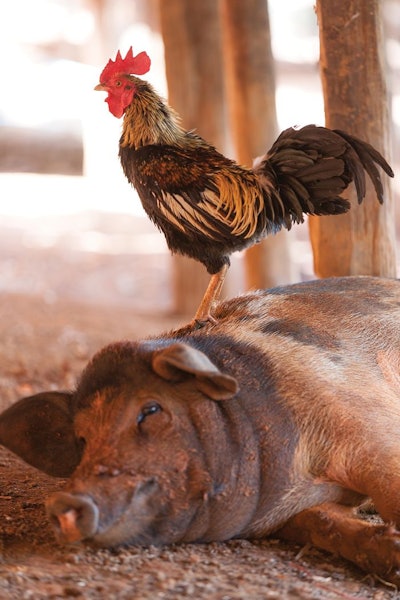
What’s in store for poultry producers in 2020? While regional difficulties may impact local poultry industries during 2020, globally, China’s ongoing struggle with African swine fever (ASF) will continue to offer a positive outlook for chicken producers worldwide.
The huge losses experienced in the Chinese pig herd and the diseases spread to neighboring countries will continue to alter demand patterns, not only for producers of poultry and other meats but also for pig producers in ASF-free countries as 2020 progresses. Plentiful feed supplies will also contribute to the favorable outlook.
The scale of this change is easily illustrated by looking at how China’s chicken meat consumption is altering. Poultry meat imports rose by 51% over the first nine months of last year and China’s poultry meat consumption is expected to reach record levels this year as consumers either reject or cannot afford pork. This will prove beneficial for those exporting countries able to sell into the Chinese market, helping to support prices on their home markets.
Poultry, along with aquaculture, are forecasted to achieve the highest growth rates this year, according to Global Animal Protein Outlook 2020, published by Rabobank.
North America
Broiler meat production in North America is forecast to reach an all-time high in 2020, accompanied by increases across all meat producing species. Yet poultry will not be the strongest performer this year; that title will go to the swine sector, with beef producers coming in third.
With new broiler capacity becoming fully operational and productivity challenges overcome, poultry meat output in the U.S. will reach record levels, but these new supplies will enter a market which is also experiencing record supplies of beef and pork, making any price improvements hard to come by.
Therein lies a problem; as demand from the home market is not expected to keep pace with this increased offering, producers will need to increasingly look to export. Prices for both poultry and pork could suffer as a consequence unless trade disputes can be resolved.
As 2019 drew to a close, however, China announced that it would end its long-standing ban on exports of U.S. poultry products, with 172 plants approved for exports by late November and more approvals expected. According to the U.S. Department of Agriculture, this resumption in exports to China is expected to result in an additional US$1 billion in revenues for U.S. producers once shipments restart.
Strong export demand, particularly from Asian countries, given the shortfall of meat due to ASF, will help to support value of dark meat for North American producers, as should normalized trade between the U.S. and Mexico. The latter’s broiler production is expected to return to normal following 2019’s avian influenza outbreak. Mexico’s meat output will rise but this is forecast to have only a small impact on available volumes.
Brazil
Driven by both domestic and foreign demand, Brazilian poultry production is forecast to rise by 2% in 2020. The country’s economic outlook has improved, with the gross domestic product expected to expand by 1.8% this year, increasing consumers’ purchasing power and this will feed through into higher meat consumption.
In export markets, poultry sales should maintain the momentum achieved in 2019. Unsurprisingly, China has become Brazil’s most important export destination for poultry meat, overtaking Saudi Arabia. China is also the principal market for Brazil’s pork exports.
Europe
Both Europe’s chicken production and exports are rising, with overseas sales expected to outperform growth on the home market during 2020.
The European poultry industry experienced a challenging 2019, with output thought to have risen by only 2.5%, following the 4.5% expansion achieved in 2018. Growth is being driven by expansion in Eastern Europe, but there has also been recent expansion in Spain. This increased supply, alongside recovering imports from Brazil, are challenging the European market, particularly for breast meat.
Europe’s exports this year are forecast to grow by 4.2%, driven by continuing demand for dark meat, particularly from Africa and Asia. While positive, growth will be slightly below that recorded for 2019.
The challenge for Europe’s poultry producers this year will be rebalancing markets, says Rabobank, adding that strong demand for dark meat products from overseas will not be enough to compensate for ongoing weak demand for breast meat at home. The key to success for Europe’s producers will be taking a more disciplined approach to supply. Growth in output for 2020 is forecast to be in the region of 2%.
China
Given the impact of ASF, it is no surprise that poultry production grew rapidly in 2019 and this year's total poultry production is expected to expand by another 10%. Demand is rising for meat from across poultry species, with production of both white- and yellow-feathered birds, spent layers, hybrid birds and waterfowl growing at a faster pace than in previous years.
China’s breeding stock inventory of white-feathered birds has improved greatly, following difficulties in sourcing supplies, suggesting that white-feathered bird production may see even stronger growth in 2020 and 2021.
The strong growth in China’s poultry imports that occurred last year, up by 51% over the first 9 months, is expected to continue into 2020, while the gap in total Chinese animal protein supply may grow further still in 2020.
Continuing to create opportunities for the country’s poultry producers, China’s pork production will further decline in 2020, some estimates suggest by as much as 15%, as the impact of ASF shows little signs of abating. The United States Department of Agriculture forecasts that China’s chicken meat consumption will reach a record 16 metric tons (mt) this year in response to the swine sector’s difficulties.
Asia
Malaysia, Indonesia, the Philippines, Singapore, and Thailand are forecast to see their poultry production grow by 4% this year to reach 9.69 mt, up slightly from 3.8% estimated for 2019. Thailand is expected to export more, and Indonesia will see production rise, but the latter, along with Thailand and the Philippines, are expected to see feed prices increase which will impact margins.
ASF is expected to continue leading to pork shortages in Vietnam and the Philippines, and Malaysia and Thailand will remain on alert to contagion. The Thai swine industry, however, is experiencing overcapacity, meaning that while other South East Asian nations may see ASF stimulate expansion of their poultry industries, this is unlikely to be as pronounced in Thailand.

Due to the lack of animal protein in China, major broiler producers are expected to see demand strongly increase as 2020 progresses. (WATT Global Media)
How the Chinese chicken market is responding to ASF
www.WATTAgNet.com/articles/37835
















